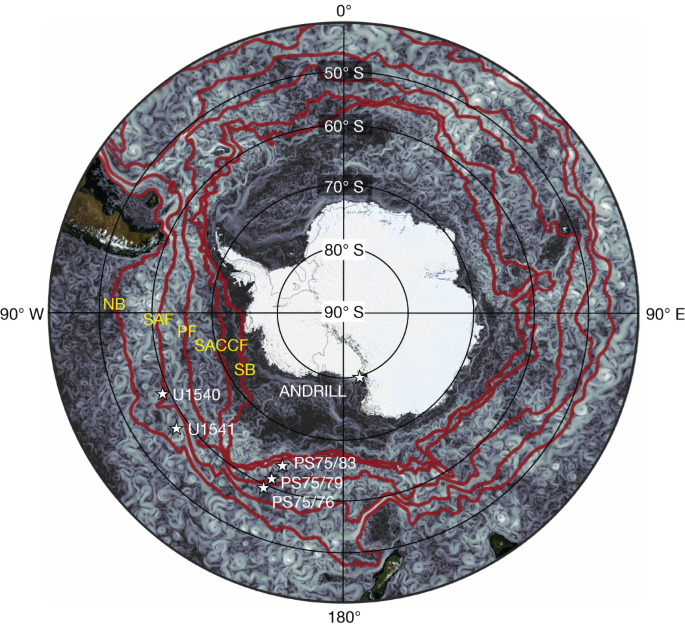Five Million Years of Antarctic Circumpolar Current Strength Variability
Core Concepts
Changes in Antarctic Circumpolar Current strength are linked to long-term climate shifts and oceanic reconfigurations.
Abstract
The Antarctic Circumpolar Current (ACC) is a crucial ocean-current system impacting global ocean circulation, climate, and Antarctic ice-sheet stability. While ACC dynamics are influenced by various factors like atmospheric forcing, oceanic density gradients, and eddy activity, the long-term evolution of ACC strength remains poorly understood. This study examines changes in ACC strength over 5.3 million years using sediment cores from the Pacific Southern Ocean. The research reveals no consistent long-term trend in ACC flow, with fluctuations observed on a million-year timescale. These variations in ACC strength are associated with Southern Ocean reconfigurations, 400,000-year eccentricity cycles, and changes in the South Pacific jet stream. The study suggests a potential increase in ACC flow with future climate warming, highlighting the complex interplay between the ACC and global climate dynamics.
Five million years of Antarctic Circumpolar Current strength variability - Nature
Stats
Today, ACC dynamics are controlled by atmospheric forcing, oceanic density gradients, and eddy activity.
We find no linear long-term trend in ACC flow since 5.3 million years ago.
ACC strength changes are closely linked to 400,000-year eccentricity cycles.
The strongest ACC flow occurred during warmer-than-present intervals of the Plio-Pleistocene.
Quotes
"The strongest ACC flow occurred during warmer-than-present intervals of the Plio-Pleistocene, providing evidence of potentially increasing ACC flow with future climate warming."
"We find ACC strength changes to be closely linked to 400,000-year eccentricity cycles, probably originating from modulation of precessional changes in the South Pacific jet stream linked to tropical Pacific temperature variability."
Key Insights Distilled From
by Frank Lamy,G... at www.nature.com 03-27-2024
https://www.nature.com/articles/s41586-024-07143-3
Deeper Inquiries
How do changes in the ACC strength impact global ocean circulation beyond the Antarctic region?
Changes in the Antarctic Circumpolar Current (ACC) strength have significant implications for global ocean circulation beyond the Antarctic region. The ACC is known to play a crucial role in connecting the world's oceans, effectively acting as a barrier between the cold Antarctic waters and the warmer subtropical waters. Variations in ACC strength can influence the transport of heat, carbon, and nutrients across ocean basins, impacting climate patterns and marine ecosystems worldwide. Stronger ACC flow can enhance the transfer of heat and carbon between the Southern Ocean and other ocean basins, affecting the distribution of nutrients and marine life. On the other hand, a weaker ACC can lead to changes in the distribution of heat and nutrients, potentially altering ocean circulation patterns and climate dynamics on a global scale.
What are the potential implications of the observed reversal in ACC strength on current climate change models?
The observed reversal in Antarctic Circumpolar Current (ACC) strength has important implications for current climate change models. The lack of a linear long-term trend in ACC flow over the past 5.3 million years challenges the assumption of a direct relationship between global cooling and increasing ice volume with ACC strength. This reversal in ACC strength suggests that the dynamics of the ACC are more complex and influenced by multiple factors, including atmospheric and oceanic forcings. Climate change models that incorporate ACC variability need to consider these non-linear trends and the impact of Southern Ocean reconfigurations on ACC sensitivity to external drivers. Understanding the mechanisms driving ACC variability can improve the accuracy of climate models and projections, enhancing our ability to predict future climate trends and their potential impacts on the Earth system.
How can the study of long-term ACC variability contribute to our understanding of past and future climate trends?
Studying long-term Antarctic Circumpolar Current (ACC) variability provides valuable insights into past and future climate trends. By analyzing sediment cores in the Pacific Southern Ocean, researchers have uncovered a million-year timescale reversal in ACC strength, linked to changes in Southern Ocean configuration and orbital forcing. This historical perspective allows us to identify patterns and cycles in ACC behavior, such as its close association with 400,000-year eccentricity cycles and precessional changes in the South Pacific jet stream. Understanding these long-term variations in ACC strength can help improve our knowledge of past climate dynamics and their drivers. Furthermore, by examining the relationship between ACC flow, opal deposition, and atmospheric CO2 levels during glacial periods, we can gain insights into the interactions between ocean circulation, carbon cycling, and climate change. This knowledge is crucial for refining climate models, predicting future climate trends, and assessing the potential impacts of global warming on the Antarctic region and beyond.
0
